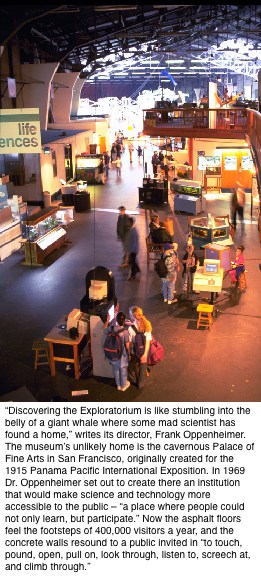| that is heard in an art gallery. Nothing in the setting, label, or symbolism suggests to the visitor that he must decide whether an exhibit is truly great art or great science or an outstanding intellectual achievement of the human mind. It is in this one respect - and only in this one - that we may conceivably fool people, because many of the things they look at really do reflect the extraordinary quality of somebody's achievement and imagination. Even in this respect, though, I doubt that we really fool people. They are certainly aware that the Exploratorium is not a trivial place. But we do nothing that would make people feel uncomfortable with non-triviality; else why do so many teachers bring students, why do so many students bring back their parents and families and friends? And why would those few adults who come alone invariably express regret that they do not have their children or grandchildren with them? I suspect that everybody - not just you and I genuinely wants to share and feel at home with the cumulative and increasingly coherent awareness of nature that is the traditional harvest of scientists and artists. The exhibits that we have designed, the thematic emphasis on perception and the general atmosphere of the Exploratorium, go a long way toward making this sharing possible for an indescribably diverse population. There is a great deal left to do and learn in order to complete what we have started. As we mature it also seems ever more important to us that we learn how to integrate what happens here with learning and enjoyment that takes place at home, in the city and country, and in schools. In the meantime, it is wonderful and rewarding to just wander around the floor, watching, listening to, and occasionally talking to the visitors. Perhaps each of us is in some way everybody, and the surest way to delight others is to find what is a delight to ourselves and to the people we are fond of. |  | ||